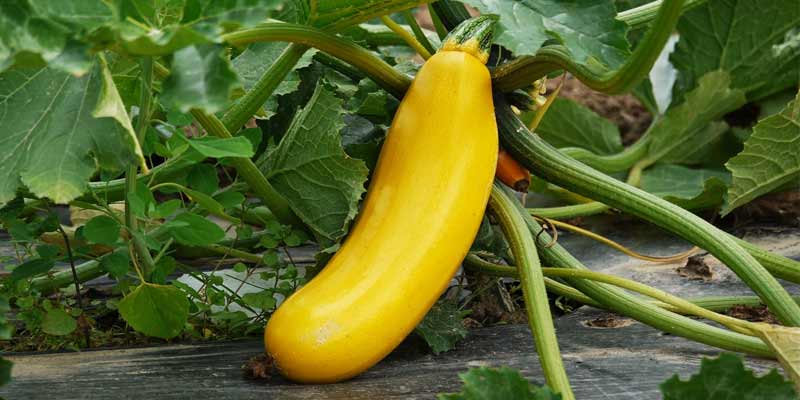Gardeners favor the versatile and nutritious summer squash, Zucchini, for its ease of cultivation and prolific harvests. Maximizing your zucchini’s yield and flavor hinges on planting them at precisely the right time.
This guide delves into factors that influence zucchini planting timing, explores ideal growth conditions, and offers tips for guaranteeing a successful harvest.
Understanding Zucchini
Scientifically termed Cucurbita pepo, zucchini resides within the cucurbit family along with cucumbers, pumpkins, and melons; this warm-season vegetable flourishes in temperatures oscillating between 70°F. to 95°F (21°C – 35°C).
Renowned for its rapid growth – an exciting process that yields copious amounts of tender green fruit – it’s a vitamin- and mineral-rich delight that is truly nature’s bounty.
3 Factors Influencing Planting Time
1. Frost Sensitivity:
High sensitivity to frost characterizes zucchini plants; hence, it is crucial to plant them after your region’s last frost date, which is a preventative measure.
Primarily, when the soil temperature ascends towards approximately 60°F (15°C), ideal conditions for planting emerge. A few weeks prior to the final frost in colder climates, initiating indoor seed growth can provide your plants with an advantageous beginning.
2. Soil Temperature
Ensure the soil temperature consistently exceeds 60°F before you plant your zucchini, as thriving in warm soil is crucial for these plants. To accurately gauge when to sow your zucchini seeds or transplant seedlings, consider investing in a soil thermometer.
3. Growing Season Duration
Typically, the zucchini’s growing season spans a relatively short period of 50 to 65 days from planting until harvest. Essential for the strategic planting of zucchinis is your understanding of this local growing season duration.
Thus, optimizing available time for these plants can contribute significantly towards producing bountiful harvests.
Ideal Planting Time
Spring Planting
In most regions, one should plant zucchini in the spring after experiencing the last frost date; this strategy enables plants to capitalize on several advantages: warm temperatures, and extended daylight hours, both characteristic of the growing season.
Moreover, an early spring plantation guarantees a mature phase for these vegetables before summer’s peak heat, thus minimizing risks associated with blossom drop.
Successive Planting
Consider implementing successive planting to prolong your zucchini harvest into the summer: this strategy entails sowing seeds or transplanting seedlings at intervals specifically, every 2-3 weeks.
Such an approach strategically staggers plant maturity; as a result, you’ll enjoy continuous and fresh supplies of zucchini instead of a single overwhelming abundance.
Fall Planting
For regions boasting mild autumn weather and an extended growing season, late summer serves as the ideal time to sow zucchini for a fruitful fall harvest. It remains paramount that these plants are afforded ample time for maturation prior to encountering their first brush with fall frost.
This particular strategy proffers substantial utility; notably empowering gardeners in capitalizing on their available growing space throughout any given year.
Optimizing Growth Conditions
1. Sunlight
Select a garden location that basks in full sunlight for at least 6-8 hours daily; this is where your zucchini plants will thrive. Robust plant growth and enhanced fruit development are the results of adequate sunlight exposure.
2. Soil Quality
For ideal zucchini cultivation, opt for soil rich in organic matter that drains well. Before planting, amend your soil with compost or well-rotted manure to offer the necessary nutrients for plant growth. Zucchini plants tend to prefer a pH ranging from slightly acidic (6.0) to neutral (7.0).
3. Watering
Throughout the growing season, zucchini plants demand consistent moisture. When you observe that the soil feels dry to the touch, provide deep watering for your plants; in addition – utilize mulch as a tool to preserve essential soil moisture.
Nonetheless, be cautious of overwatering—excessive wetness may trigger root rot within these vegetables due to their sensitivity to such conditions.
Harvesting Zucchini
As important as timing your initial planting, is understanding the optimum period for zucchini harvest. Opt for young and tender fruits, ideally measuring between six to eight inches in length; this practice of regular harvesting will foster an increased fruit yield from the plant.
Conclusion
To cultivate zucchini with success, one must plant them at an appropriate time. Key steps to guarantee a bountiful harvest of this delicious summer squash include understanding the factors that influence planting time, taking into account your local climate, and optimizing growing conditions.
If you adhere to these guidelines, indulging in homegrown zucchini throughout the growing season is within reach for you. Happy gardening!



